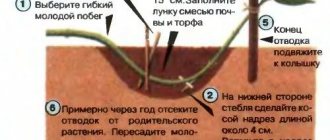Santolina is an evergreen plant native to the Mediterranean. The unusual appearance of this overseas beauty makes it a welcome guest in garden plots and as a houseplant. It will, without a doubt, become the center of attention in any flower bed, alpine hill, or rock garden. Some types of santolina are used not only as a garden flower, but also as an aromatic food seasoning, as well as a moth repellent in linen closets.
Description
Santolina silver belongs to the genus of bush-like plants of the Asteraceae or Asteraceae family. In botanical literature it is sometimes found under the name “cotton lavender,” although it has nothing in common with this plant. Prefers rocky, dry soil and can bloom even on poor soils. The plant is drought-resistant and easily tolerates a lack of moisture in the soil.
In its homeland, in Mediterranean countries, an evergreen shrub can live in one place for many years. In the middle zone, santolina is grown as a perennial and annual crop. Growing and caring for santolina is quite simple.
The plant cannot boast of good cold resistance; without reliable shelter the bush will simply freeze.
To preserve the plant, the bushes are dug up in the fall, placed in flower tubs and stored indoors. And in the spring they are returned to their original place in the garden.
Santolina is a lush shrub and subshrub. The largest representatives of the genus grow up to 1 m in height, the average height of the bush is 30–50 cm. The stems are arched, highly branched, thin, and pubescent. At 2–3 years of life, old shoots become woody. The leaves are small, dissected, narrow, evergreen, silvery in color.
At the tops of the stems, single voluminous, lush, spherical or flat flowers of white, cream or golden color, up to 3–5 cm in diameter, are formed. The flowers extend 10–20 cm beyond the crown of the bush. The above-ground part of the plant exudes a spicy aroma. In open ground, flowering begins in July and lasts until the end of the growing season. In a city apartment, santolina flowers are a rare occurrence. Perhaps the bush will bloom if the flower pot is exposed to the open air in summer.
Beneficial features
Santolina has “healthy” beauty - the plant contains essential oils. Young shoots and leaves are used as a seasoning for cooking. Greenish and rosemary-leaved santolina varieties are best suited for this purpose. It enriches dishes with new flavors and has a beneficial effect on the functioning of the digestive system.
Freshly squeezed juice from the shoots is used to relieve itching and irritation from mosquito and midge bites. Dried flowers and leaves serve as an excellent means of repelling moths and scenting things in the closet.
Brief description of Santolina
Depending on the variety, santolina flowers can be either rich yellow or light sand.
This Mediterranean evergreen branching perennial plant is a low shrub or subshrub with fragrant tubular flowers collected in small spherical baskets. Its leaves, similar to cypress branches, are silver-gray. Their scent is reminiscent of wormwood. The height of the bushes is half a meter. Santolina grows best in sunny, dry places without stagnant water, and prefers light, sandy or rocky soil with coarse sand or small stones for drainage.
Spring pinching gives the bush splendor and decorativeness, this allows the development of numerous side shoots.
In its homeland, in a mild climate, it is an evergreen perennial, but in the middle zone it is grown as an annual.
The openwork dissected young leaves are painted in a light green shade, and then a silvery fluff appears on them. Flowering under favorable conditions is observed from June to September. Many insect pests, especially moths, do not like the spicy smell of yellow buds. The inflorescences are located on a thin stem up to 25 cm long.
The special attractiveness of santolina is not in its button flowers, but in the unusual shape of the leaves. Their decorativeness depends on the growing conditions; when there is insufficient lighting, the shoots become very elongated and the bush falls apart, acquiring an unkempt appearance.
Santolina varieties
In gardening, the number of popular varieties of Santolina is about 80. Most of them are sold in nurseries and specialized stores.
Cypress
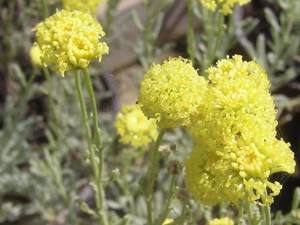
Santolina cypress
A neat rounded bush up to 50 cm high. The foliage is small, dissected, at the beginning of the growing season it has a green tint, and as it grows the color changes to silver. The bush exudes a pleasant, olive aroma.
Cirrus
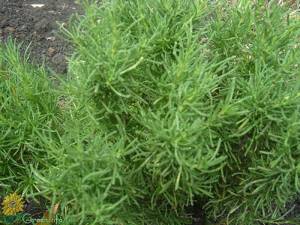
Santolina pinnate
The variety has a neat appearance. The stems are thin, highly branched. The height of the bush is approximately 60 cm. The leaves are light green, thin, up to 4 cm long. Flowers in the form of white or cream small pompoms are formed on the tops of the branches of the bush. Santolina pinnate leaves the impression of an airy green cloud.
Neapolitan
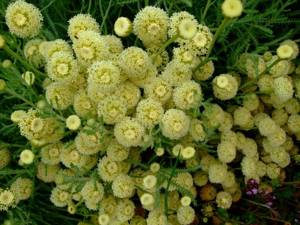
Santolina neapolitan
Of all the representatives of the Santolina genus, the Neapolitan variety is the tallest. It reaches 1 m in height. Bright, yellow, fragrant flowers cover the bush in abundance.
Greenish
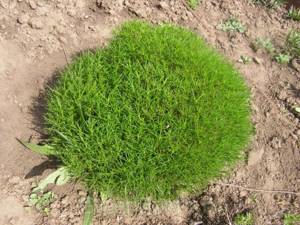
Santolina greenish
The variety is much more often used for garden landscaping than others. One of the advantages of the variety is its ability to survive temperatures dropping to -7...-10 degrees. The bush is branched, up to 80 cm high. It differs from other species in its more saturated, bright green color. The leaves are thin, pinnately dissected. The bush has an airy, fluffy appearance. Round, cream-colored flowers. The variety is used for making seasonings.
Graceful
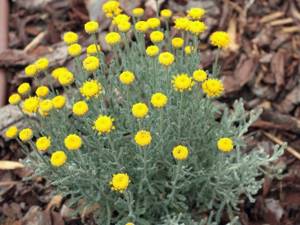
Santolina graceful
The variety does not tolerate cold drafts and winters. It is mainly grown in warm climate zones. The stem and leaves are grey, silver. Yellow single flowers bloom above the bush on high stalks.
Rosemary leaf
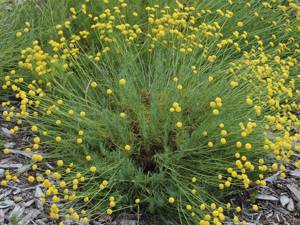
Santolina rosmarinifolia
The name of the variety speaks for itself. The leaves are narrow, long, pinnately dissected. Externally, the bush is vaguely similar to rosemary. The above-ground part of the plant is fragrant. Many people grow rosemary-leaved santolina as a spicy addition to dishes.
Santa
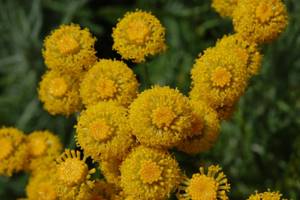
Santolina Santa
The miniature fragrant bush grows no more than 40 cm in height. The top of the compact plant is framed by numerous golden flowers.
Caring for Santolina after planting
The plant is undemanding to maintenance. Basic care after planting Santolina is:
- in loosening the soil around the root collar;
- in weeding and removing various herbs;
- in periodic moderate watering;
- in organizing shelter for the cold season.
Watering
Santolina suffers greatly from stagnation of water in the ground. It is watered when the top layer of soil dries. The water for irrigation must be warm. With excessive watering, the shoots turn yellow and the roots rot. If there is a lack of moisture in the soil, the bush loses its elasticity. These are the main signals to review the mode and amount of watering.
Top dressing
During the growing season, for the growth and lush bright flowering of garden santolina, the plant is fertilized 1-2 times a month. For these purposes, complex mineral fertilizers with a low nitrogen content are used. More frequent feeding affects the decorative appearance of santolina - the bush blooms less readily, the flowers become smaller.
Pruning in spring and autumn
Santolina is a representative of garden flora that tolerates pruning well. Using pruners or garden shears, the bush is given the desired shape. They often form neat rounded bushes. You can trim santolina at any time, but the main pruning is carried out in the spring - before growth and budding begins, and in the fall - after the bush has flowered.
With spring pruning, old, damaged and woody branches are removed. In autumn, the bush is shortened by more than half. The purpose of this procedure is to maintain the compact shape of the bush.
In the coming spring, after the autumn “haircut”, the bush will branch well. If this is not done, the plant will stretch out, fall apart in the middle due to excessive growth, lose its shape, and take on an extremely untidy appearance. Pruning maintains a decorative appearance and rejuvenates the bush. Throughout the growing season, dried, yellowed twigs are removed.
When is a transplant needed?
As for transplantation, the timing differs for home and garden santolina. So, if the bush grows in open ground, then replanting is carried out every 5 years. Otherwise, the plant degenerates, falls apart and loses its decorative appearance. It is advantageous to combine replanting with dividing the bush. The main thing is that a small area with rhizomes remains on the plots. The separated parts are planted in a new place, in moist, loose soil. “Indoor” santolina is replanted annually.
Wintering in the open ground
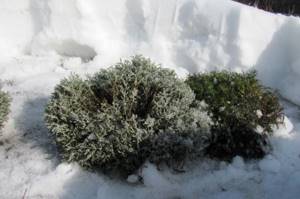
In the middle climate zone, Santolina does not survive the cold season well. If the bush remains in the open ground all year round, then you should take care of good shelter for the winter. With the first frost, the soil around the bush is mulched with sand, coal or spruce needles. The larger the layer of mulch, the greater the chance of saving the roots from freezing.
The top of the bush is covered with spruce branches or straw, a wooden box, and covering material is pulled over it. With such protection from cold winds and frosts, Santolina has every chance of surviving the winter in open ground.
Diseases and pests of Santolina
The plant rarely gets sick and is subject to attacks by insect pests. Problems arise only when the conditions for growing and caring for the plant are violated:
- Lack of water in the soil.
- The plant loses its elasticity, withers, leaves and stems turn yellow.
- The soil is wet for a long time.
- The root system is rotting.
- Insufficient lighting.
- The bush loses its elastic spherical shape, disintegrates and stretches, and does not bloom.
- Insects are pests.
The plant is often attacked by spider mites and aphids. At the same time, the foliage turns yellow and curls. To control pests, use soapy water, garlic or onion infusion. In advanced cases, they resort to the help of fungicides.
Planting santolina in open ground
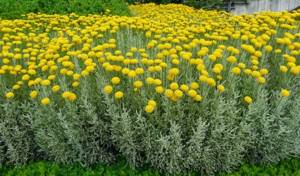
Proper planting in open ground and caring for Santolina will ensure active growth, bright and lush flowering. The bush needs an open sunny place. In the shade, santolina becomes shapeless, loose, the branches do not hold their shape. The bush gradually stretches out, loses its spherical appearance, falls apart, and the aroma becomes unnoticeable. The planting site is protected from drafts, since in the first year of life young seedlings are weak. Bushes older than three years old are not bothered by drafts, although this does not mean that they need to be planted in a heavily blown place.
In the area where santolina grows, stagnation of water is dangerous. Excess moisture in the soil will have a detrimental effect on the condition of the roots, they will begin to rot.
The soil selected is dry, loose, and well-permeable to water. Before planting, it is advisable to organize a drainage layer to drain excess water. On fertile soil, the bush actively grows and branches; on poor soil, santolina blooms luxuriantly and profusely.
In the spring, the planting beds are dug up, loosened, and various roots are removed. If the soil is heavy, sand is added to the soil. Organize a drainage layer. They mark the rows by digging shallow trenches. Young bushes are taken out of the pot and the soil is lightly shaken off the roots. Plant 2–4 pieces together at a distance of 10–30 cm from each other. Dig in the roots, sprinkle with humus, and compact them near the root collar. Water thoroughly over the next 3-4 days. As soon as the bush “comes to life” after planting, watering is reduced.
Reproduction methods
The shrub is grown mainly by seed, dividing the bush and cuttings. The seed method is more often used by gardeners in the northern regions when growing seedlings at home.
Growing from seeds
They begin growing seedlings in mid-spring. To do this, gardeners purchase soil for seedlings and planting material from a specialized store. A drainage layer of expanded clay or small stones is placed at the bottom of pre-prepared containers. The bottom of the container should also have holes for drainage. The containers are filled with soil and moistened abundantly.
Since the seeds are too small, they are laid out on the surface of the soil and covered with a layer of light fertile mixture 0.5 cm thick. The top layer is carefully moistened with a spray bottle so as not to wash out the seeds. The containers are covered with plastic or cling film with small holes and put in a warm and bright place. The temperature should be in the range from 18 to 20° C.
After two or three weeks, the first shoots should appear. When 2-3 leaves appear, the seedlings are picked. To do this, each seedling is transplanted into a separate pot with fertile soil. During the growing process, seedlings are hardened. With the onset of warm days, gardeners take the seedlings out onto the loggia or glassed-in balcony for the day. Planting in open ground begins in late spring or early summer.
Method of cutting and dividing a bush
Cuttings begin in the spring in warm climate zones, and in the fall in cold climates. To do this, cut blanks 10-15 cm long from the shoots. The cuttings are completely cleaned, collected in a bunch and stored in a basement or cellar for the winter. In the spring, they are taken out and soaked for a day in a solution of a growth stimulator.
Rooting can be done directly in the soil for seedlings. To do this, pour it into pots, moisten it abundantly and plant cuttings. Then each seedling is covered with a glass jar or cut plastic bottle. All these activities are carried out at home, and seedlings are planted in open ground in the summer.
Step-by-step instructions for propagation by seeds and cuttings
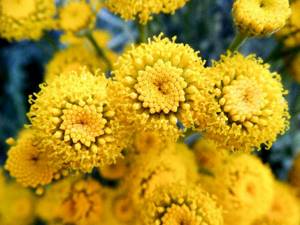
Santolina is propagated by dividing the bush, cuttings and seeds. Divide the bush in spring and autumn when replanting. By combining these two procedures you can rejuvenate the bush and get several new ones. Santolina is easy to propagate by cuttings and seeds. Each technique has its nuances. Depending on capabilities and desires, each gardener chooses the one that is most suitable. Having a santolina bush in the garden, it is easier to use propagation by cuttings. Those who want to get acquainted with the plant begin to grow the flower from seeds.
Propagation by seeds
The seedling method of growing Santolina has proven itself to be excellent. Before sowing, the seeds are subjected to monthly stratification. They are wrapped in damp cloth and stored in the refrigerator. At the end of winter - beginning of spring, preparations begin for sowing seeds for seedlings.
Soil preparation
A soil mixture of equal parts of turf soil and sand is well suited for young Santolina.
Selection of capacity
Small, wide containers with sufficient drainage holes at the bottom are best suited. Drainage is placed at the bottom of the pots - expanded clay, small broken bricks, crushed nut shells, etc.
Sowing
The seeds are deepened into the soil by 1–2 cm. The soil is moistened with warm water from a spray bottle.
Growing conditions
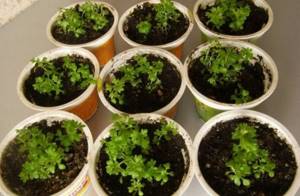
The container is placed in a warm, bright room, kept at a temperature of +18...+20 degrees. The first shoots will appear after 1.5–2 weeks. After the formation of 3–4 true leaves, the young shoots are transplanted into separate containers. In summer, seedlings are planted in a permanent place in the garden.
Santolina seeds are sown in open ground in the summer, when the soil is well warmed up. The beds with seeds are covered with a greenhouse. June is the best time to sow seeds. After 15–20 days, the first shoots appear.
Reproduction by cuttings
To successfully root cuttings, adhere to the following algorithm:
Material
For this method of propagation, young branches are cut from an adult bush in March - April. Old, woody and last year's shoots are not suitable for this method of propagation. Cuttings 8–15 cm long are cut with part of the trunk.
Preparation of cuttings
Treating cuttings with a root formation stimulator will have a positive effect on rooting.
Soil preparation
To root the material, mix 2 parts sand and 1 part leaf soil. Or they just use sand.
Selection of capacity
Use a wide box or individual cups. In any case, conditions are created under which it remains possible to cover the cuttings with glass, polyethylene or a transparent cap.
Growing conditions
Every day you should remove the cover from the container for 10–20 minutes for ventilation. The soil should be periodically sprayed with warm water. The soil should not dry out, but it is also not advisable to keep it wet.
If the cuttings are planted in a common container, then after rooting they are planted 2-3 pieces in separate pots.
As soon as the cutting begins to grow, its crown is pinched to stimulate branching. In open ground, young plants are planted in June.
Reproduction methods
Seeds can be sown in open ground already in established warm weather, and if we are talking about a room or greenhouse, then in the spring. As a rule, sprouts will appear within three weeks and do not require special care.
For cuttings, you will need an already mature plant, from which shoots are cut, the length of which can be from eight to fifteen centimeters. You need to cut it at the end of winter or early spring, and then place the cutting in a container with damp sand and leaf soil. The planting must be covered, and the rooted cuttings are then planted in groups of three. It can only be planted in open ground in June.
Santolina is great for growing in pots as a beautiful decoration on balconies and terraces.
Application in landscape design

Santolina is an ideal plant to decorate the garden. Flowers look great on an alpine hill, slope, crushed stone flower bed, as borders, hedges, and even as a single element of the garden. Wherever santolina grows, it will attract glances with its unique beauty. Lavender, sage, lemon balm, cloves, and jasmine will be excellent neighbors for the bush. On the alpine hill, the lush santolina will become the highlight of the garden. Many drought-tolerant plants complement the ensemble with silver beauty well. By giving the bush different shapes, unusual compositions are created.
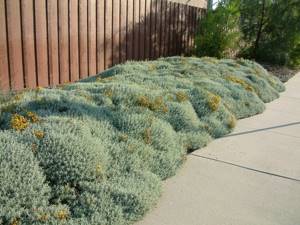
The amazing beauty of Santolina will not leave anyone indifferent. Once planted, it will become a permanent resident of the garden. Its unpretentious disposition and unusual appearance elevates this plant to the rank of favorites. By growing santolina, you can provide yourself with delicious seasoning, aromatic and healing herbs for a long time.
Santolina contraindications
- Do not forget that flowers contain pollen, a strong allergen.
- Drinking tea or applying a bandage is strictly prohibited for allergy sufferers.
- It is recommended that people with diabetes mellitus be careful.
- There is no harm from santolina, just as there is little benefit from it.
Santolina, although it is a medicinal herb, is now more likely to be used by people as an ornamental plant than as a medicinal plant. It has found little use in medicine, but is widely used as a decorative plant.
